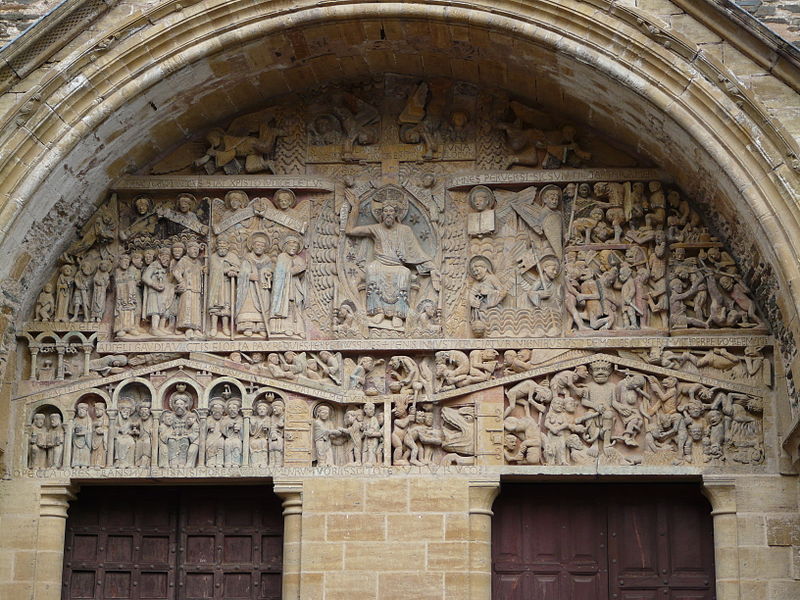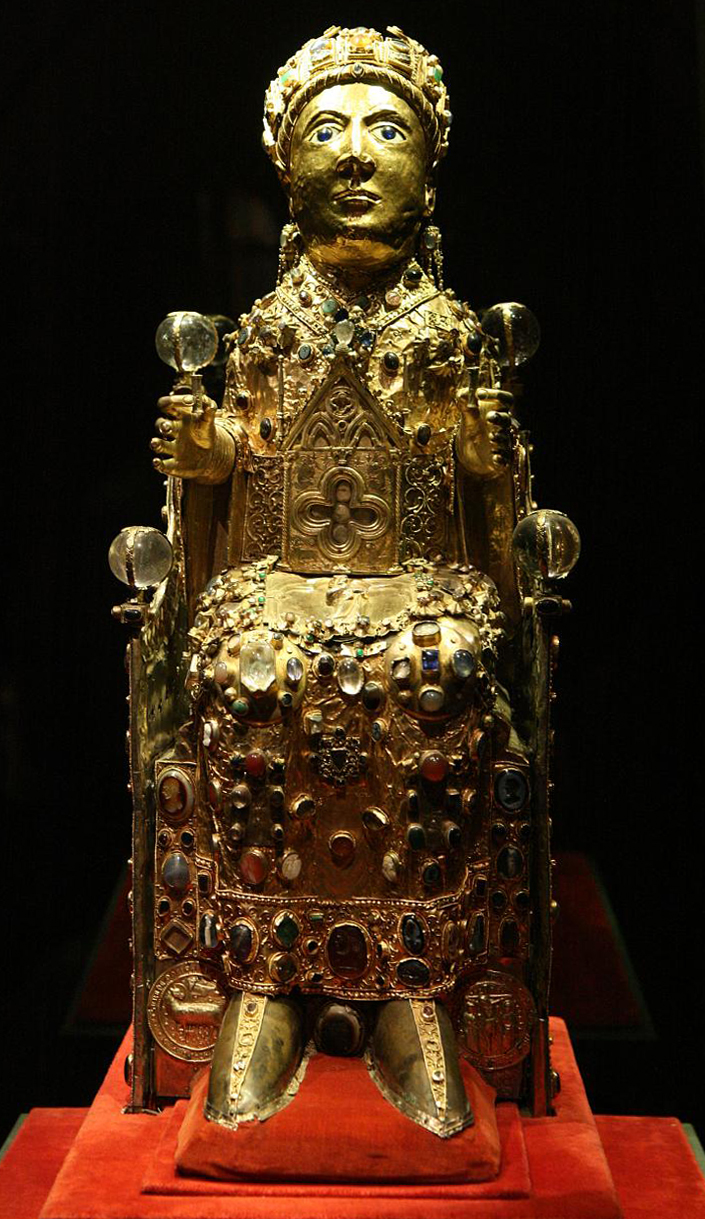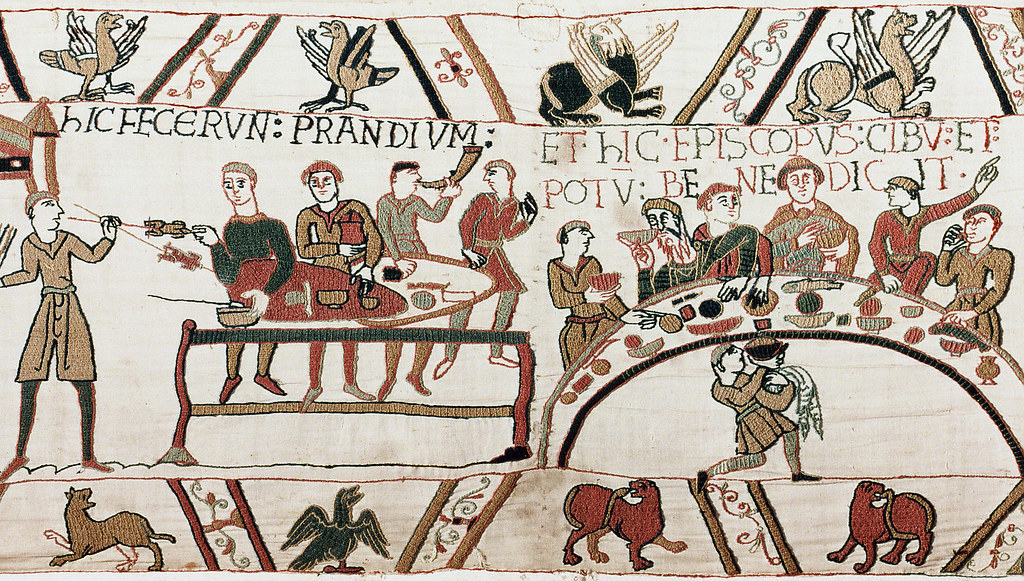Chapter 11: Romanesque
Key Notes
- Time Period: 1050–1150, some objects date as early as 1000 and late as 1200
- Culture, beliefs, and physical settings
- Romanesque art is a part of the medieval artistic tradition.
- In the Romanesque period, royal courts emphasized the study of theology, music, and writing.
- Romanesque art avoids naturalism and emphasizes stylistic variety. Text is often incorporated into artwork from this period.
- Cultural interactions
- There is an active exchange of artistic ideas throughout the Middle Ages.
- There is a great influence of Roman, Early Medieval, and Islamic art on Romanesque art.
- Audience, functions and patron
- Works of art were often displayed in religious or court settings.
- Existing architecture is mostly religious.
- Theories and Interpretations
- The study of art history is shaped by changing analyses based on scholarship, theories, context, and written record.
- Contextual information comes from written records that are religious or civic.
Historical Background
- By 1000, Europe had settled down following the enormous migration of the Early Medieval era.
- Viking ancestors conquered Normandy, France, southern Italy, and Sicily after being Christianized.
- Spanish and North African attacks were neutralized, and Europeans started the Crusades to invade Muslim areas.
- The pope led Europe's Christian empire, which resembled the Roman secular empire.
- Even though Europeans battled equally, commerce and the arts flourished, and cities thrived for the first time in generations.
- People traveled throughout Europe on religious pilgrimages to Rome and Jerusalem.
- The Santiago de Compostela shrine to Saint James was the most popular.
- As the conclusion of western European pilgrimages, a beautiful Romanesque cathedral was erected.
- To provide travelers with more sacred sites, shrines were built at strategic spots along the path.
- One of history's greatest revitalizations was this pilgrimage movement and associated construction boom.
Patronage and Artistic Life
- Feudalism: a symbiotic connection between lords and peasants—dominated medieval life.
- Farmworkers fed everyone.
- Landowners protected peasants.
- Between these locations, artists become middle class.
- Painting was valued more than sculpture or building since artists worked less with their hands.
- Women were limited to "feminine handicrafts" including pottery, weaving, and manuscript decorating.
- Queens, abbesses, and other powerful women funded nunneries and illuminated manuscripts.
- Nun Hrotswitha of Gandersheim created plays like Roman poets and playwrights.
- Hildegard von Bingen, a musician, author, and patroness, was a genius of the time.
- Although Christian works dominate Romanesque art, many wonderfully made secular works exist.
- Medieval secular and religious works frequently shared symbolism.
- Medieval architecture emphasizes castles, manors, monasteries, and cathedrals.
- Master builders, not architects, designed them and hired the workers.
- Skilled artists oversaw the building's design with these master builders.
Romanesque Architecture
- Civic pride, creative expression, and spiritual devotion were found in cathedrals.
- They took hundreds of years to build
- They were quite costly
- They were carefully built and maintained.
- Church leaders replaced wood roofs with stone to prevent fires.
- Wood-built ones were occasionally retrofitted.
- Cathedral: the principal church of a diocese, where a bishop sits
- The period's moniker, "Romanesque," comes from this resurgence of stone constructions.
- However, stone was problematic.
- It's heavy, thus the walls must be thicker to support the roof.
- To minimize wall holes, windows are modest.
- It's dark inside.
- To let more light into the structure, the outside of the windows is thin and the inside is bigger.
- However, stained glass dimmed rooms.
- The rib vault was invented by expert builders to sustain these large structures' roofs.
- Rib vault: a vault in which diagonal arches form riblike patterns. These arches partially support a roof, in some cases forming a web-like design
- These ribs were originally ornamental moldings on groin vaults, but they later formed a new roof support system.
- While they do not hold their whole weight, they assist transmit their burden down to the walls and onto the gigantic piers below, which act as buttresses.
- Rib vaults open up ceiling spaces, allowing for bigger clerestory windows.
- Clerestory: the window story of a church
- Rib vaults were created first, followed by stones in the intervals between.
- Stone is fireproof and has additional benefits.
- It's robust and waterproof.
- It also conducts sound effectively, allowing medieval music with Gregorian chant to be sung so that even people in the back of these massive structures could hear the service.
- The medieval bay is the building block.
- This space has an arch on the first level, a triforium with smaller arches on the second, and windows in a clerestory on the third.
- Triforium: A narrow passageway with arches opening onto a nave, usually directly below a clerestory
- The bay's shape was duplicated throughout the cathedral to create an aesthetic unity.
- Bay: a vertical section of a church that is embraced by a set of columns and is usually composed of arches and aligned windows
- An ambulatory, also seen in Early Christian churches, was added to the east end of Romanesque structures to accommodate huge crowds on feast days and pilgrimages.
- This pathway directed spectators around the cathedral without interrupting the apse festivities.
- Pilgrims may see relics and other religious things in chapels spaced throughout the ambulatory.
- They perform well in this environment at Saint Sernin's ambulatory.
- Abbey: a monastery for monks, or a convent for nuns, and the church that is connected to it
- Ambulatory: a passageway around the apse of a church
- Apse: the end point of a church where the altar is
- Italian buildings have separate bell towers called campaniles to summon people to prayer.
- Campanile: a bell tower of an Italian building
- Northern European buildings incorporate this ower into the fabric of the building often over the crossing.
- Arcade: a series of arches supported by columns. When the arches face a wall and are not self-supporting, they are called a blind arcade
- Baptistery: in medieval architecture, a separate chapel or building generally in front of a church used for baptisms
- Compound pier: a gathering of engaged shafts around a pier
- Gallery: a passageway inside or outside a church that generally is characterized by having a colonnade or arcade
- Jamb: the side posts of a medieval portal
- Narthex: the vestibule, or lobby, of a church
- Portal: a doorway. In medieval art they can be significantly decorated
- Trumeau (plural: trumeaux): the central pillar of a portal that stabilizes the structure. It is often elaborately decorated
➼ Church of Sainte-Foy
Details
- Romanesque Europe
- c. 1050–1130, stone
- Conques, France
Form
- Church built to handle the large number of pilgrims: wide transepts, large ambulatory with radiating chapels.
- Radiating chapel: a chapel that extends out in a radial pattern from an apse or an ambulatory
- Transept: an aisle in a church perpendicular to the nave
- Massive heavy interior walls, unadorned.
- No clerestory; light provided by windows over the side aisles and galleries.
- Barrel vaults in nave, reinforced by transverse arches.
- Transverse arch: an arch that spans an interior space connecting opposite walls by crossing from side to side
- Cross-like ground plan, called a Latin cross.
Function
- Christian church built along the pilgrimage road to Santiago de Compostela, a popular pilgrimage center for the worship of the relics of Saint James.
- Radiating chapels housed relics of the saints.
Images

Romanesque Sculpture and Painting
- Large-scale stone sculpture was rare in the Early Medieval period, but the Romanesque revived it.
- Sculptors were inspired by goldsmiths and other metal artisans, but they created life-size sculptures.
- Sculpture was often put around medieval church doorways to help worshipers grasp the building's subject.
- As before, ivories, wooden things, and metallurgy flourished.
- Illuminated manuscripts and the odd ceiling or wall mural tell us most about Romanesque art.
- Figures are often black-outlined and brightly colored.
- Since gestures and emotions are magnified, heads and hands are proportionately the biggest characteristics.
- Figures seem to float because they fill a blank surface.
- As in the Bayeux Tapestry, they sometimes tiptoe or glide.
- People dominate structures that seem like props or stage sets in most Romanesque artwork.
- Romanesque churches are known for painted stone sculpture.
- Capitals are carved with Bible scenes.
- The gateway is Romanesque sculpture's crowning achievement.
- These masterpieces are in such a prominent place that sculptors competed to carve them.
- Famous painters were sought by municipalities.
- Their autographs express their greatness.
- Despite geographical differences, Romanesque sculpture has certain common traits.
- Flattened figures with zigzagging draperies obscure body shape rather than define it.
- A hierarchy of figures is thoroughly developed.
- Borders are used to frame situations for figures.
- Preferring to be defined by these boundaries, they seldom challenge them.
- This epoch also saw smaller, autonomous sculptures.
- Reliquaries with treasured relics like saints' bones are cherished and lavishly decorated.
- Reliquary: a vessel for holding a sacred relic. Often reliquaries took the shape of the objects they held. Precious metals and stones were the common material
➼ Last Judgment
Details
- 1050–1130
- Made of stone and paint
- Found in Sainte-Foy, Conques
- Last Judgment: in Christianity, the judgment before God at the end of the world
Form
- Largest Romanesque tympanum.
- Tympanum (plural: tympana): a rounded sculpture placed over the portal of a medieval church
- 124 figures densely packed together; originally richly painted.
Function
- Last Judgment cautions pilgrims that life is transitory and one should prepare for the next life.
- Subject of the tympanum reminds pilgrims of the point of their pilgrimage.
Content
- Christ, as a strict judge, divides the world into those going to heaven and those going to hell.
- Christ is depicted with a welcoming right hand, a cast down left hand.
- Christ sits in a mandorla.
- Mandorla: (Italian for “almond”) an almond-shaped circle of light around the figure of Christ or Buddha
- A dividing line runs vertically through the cross in the middle of the composition.
- The Archangel Michael and the devil are at Christ’s feet, weighing souls.
- Hell, with the damned, is on the right.
- People enter the church on the right as sinners and exit on the left as saved; the right door has sculptures of the damned and the left door has images of the saved.
- The figures of the saved move toward Christ, Mary, and Saint Peter; local abbots and monks follow Charlemagne, the legendary benefactor of the monastery, who is led by the hand.
- Paradise, at the lower level, is portrayed as the heavenly Jerusalem.
- Sainte Foy interceded for those enslaved by the Muslims in Spain—she herself appears kneeling before a giant hand of God.
- On the right lower level, the devil presides over a chaotic tangle of tortured condemned sinners.
- Inscription on lintel: “O Sinners, change your morals before you might face a cruel judgment.”
- Hieratic scale may parallel one’s status in a feudal society.
Image

➼ Reliquary of Sainte-Foy
Details
- Made of gold, silver, gemstones, and enamel over wood.
- 9th century, with later additions
- Found in Sainte-Foy, Conques
Form
- Child saint’s skull is housed in the rather mannish-looking enlarged head.
- Jewels, gems, and crown added over the years by the faithful, as acts of devotion.
- Facial expression is haughty and severe.
Function: Reliquary of a young girl martyred in the early fourth century.
Context
- Sainte Foy (or Faith) probably died as a martyr to the Christian faith during the persecutions in 303 under Emperor Diocletian; she was tortured over a brazier; she refused to sacrifice to the Roman gods in a pagan ritual.
- Saint Foy, triumphant over death, looking up and over the viewer’s head.
- Relics of her body were stolen from a nearby town and enthroned in Conques in 866.
- One of the earliest large-scale sculptures in the Middle Ages.
Image

➼ The Bayeux Tapestry
Details
- Romanesque Europe (English or Norman)
- 1066–1080
- Made of embroidery on linen
- Found in Bayeux Tapestry Museum, Bayeux, France
- Embroidery: a woven product in which the design is stitched into a premade fabric
- Tapestry: a woven product in which the design and the backing are produced at the same time on a device called a loom
Form
- Color used in a decorative, although unnatural, manner—different parts of a horse are colored variously.
- Neutral background of unpainted fabric.
- Flat figures; no shadows.
Content
- Tells the story (in Latin) of William the Conqueror’s conquest of England at the Battle of Hastings in 1066.
- The story, told from the Norman point-of-view, emphasizes the treachery of Harold of England, who breaks his vow of loyalty and betrays William by having himself crowned.
- More than 600 people, 75 scenes.
- Fanciful beasts in upper and lower registers.
- Borders sometimes comment on the main scenes or show scenes of everyday life.
Function
- Uncertainty over how this work was meant to be displayed, perhaps in a cathedral hung from the pillars in the nave or hung in a hall along a wall.
Technique
- Tapestry is a misnomer; actually, it’s an embroidery.
- Probably designed by a man and executed by women.
Patronage: Commissioned by Bishop Odo, half-brother to William the Conqueror.
Context
- Continues the narrative tradition of medieval art; 230 feet long.
- Narrative tradition goes back to the Column of Trajan
Image

